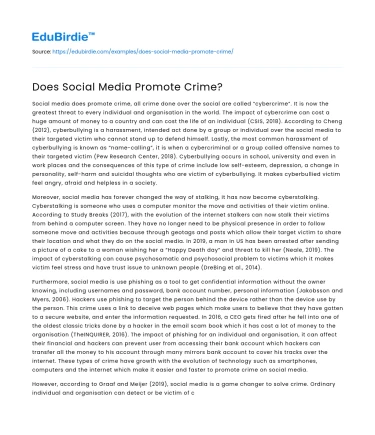Social media does promote crime, all crime done over the social are called “cybercrime”. It is now the greatest threat to every individual and organisation in the world. The impact of cybercrime can cost a huge amount of money to a country and can cost the life of an individual (CSIS, 2018). According to Cheng (2012), cyberbullying is a harassment, intended act done by a group or individual over the social media to their targeted victim who cannot stand up to defend himself. Lastly, the most common harassment of cyberbullying is known as “name-calling”, it is when a cybercriminal or a group called offensive names to their targeted victim (Pew Research Center, 2018). Cyberbullying occurs in school, university and even in work places and the consequences of this type of crime include low self-esteem, depression, a change in personality, self-harm and suicidal thoughts who are victim of cyberbullying. It makes cyberbullied victim feel angry, afraid and helpless in a society.
Moreover, social media has forever changed the way of stalking, it has now become cyberstalking. Cyberstalking is someone who uses a computer monitor the move and activities of their victim online. According to Study Breaks (2017), with the evolution of the internet stalkers can now stalk their victims from behind a computer screen. They have no longer need to be physical presence in order to follow someone move and activities because through geotags and posts which allow their target victim to share their location and what they do on the social media. In 2019, a man in US has been arrested after sending a picture of a cake to a woman wishing her a “Happy Death day” and threat to kill her (Neale, 2019). The impact of cyberstalking can cause psychosomatic and psychosocial problem to victims which it makes victim feel stress and have trust issue to unknown people (DreBing et al., 2014).
Save your time!
We can take care of your essay
- Proper editing and formatting
- Free revision, title page, and bibliography
- Flexible prices and money-back guarantee
Furthermore, social media is use phishing as a tool to get confidential information without the owner knowing, including usernames and password, bank account number, personal information (Jakobsson and Myers, 2006). Hackers use phishing to target the person behind the device rather than the device use by the person. This crime uses a link to deceive web pages which make users to believe that they have gotten to a secure website, and enter the information requested. In 2016, a CEO gets fired after he fell into one of the oldest classic tricks done by a hacker in the email scam book which it has cost a lot of money to the organisation (TheINQUIRER, 2016). The impact of phishing for an individual and organisation, it can affect their financial and hackers can prevent user from accessing their bank account which hackers can transfer all the money to his account through many mirrors bank account to cover his tracks over the internet. These types of crime have growth with the evolution of technology such as smartphones, computers and the internet which make it easier and faster to promote crime on social media.
However, according to Graaf and Meijer (2019), social media is a game changer to solve crime. Ordinary individual and organisation can detect or be victim of cybercrime which they can help the police force to acts against these criminals with enough evidence gather to charge them. Denouncing these crimes make the society feel empowered and safe, and it reduces the level of crime committed in the society. In 2010, three British women turn into investigators on social media to bring an American “suicide voyeur” to justice who was encouraging depressed people to commit suicide and wanted to watch his target die using a webcam (Alderson, 2010). The finding of the three women were sent to the US authorities to charge the suspect with the evidence gather against him.
Likewise, social media is now use by police forces as a means of improving the confidence of the society and better comprehend the needs of the society. The police force uses social media to acquire effective local media strategy in order to neutralise some of the effect cause by the national media reporting (Copitch and Fox, 2013). They create public awareness by encouraging citizens to denounce suspicious activities occurs on social media and create post to inform the public about the investigation’s process and post picture of suspect who are committing a crime which it needs to be identify. In 2016, a man was scrolling through his social media newsfeed when he recognised a picture of his friend committing a crime, he felt obligated to denounce his friend to the authorities to make the arrest (Dughi, 2016).
However, social media is now use to enhance research and learning at university level by helping student to improve their communication skills by expressing themselves in writing to share their poetry or talk about their ideas with other students and get comment like opinion from their friends they trust which it can encourage students to write more. According to Minocha (2009), social media has additionally been utilised for formal learning with academics by creating open or private group for classroom practices. Lecturer can send courses or guidelines for an assignment or any academics research related in order to improve communication between student and lecturer and provide a platform where teachers can answer any academic question (Minocha,2009). The use of social media by students in their everyday lives and more use of technology in academic context can lead to increase preparation and engagement in their research (Ivala and Gachago, 2012).






 Stuck on your essay?
Stuck on your essay?

